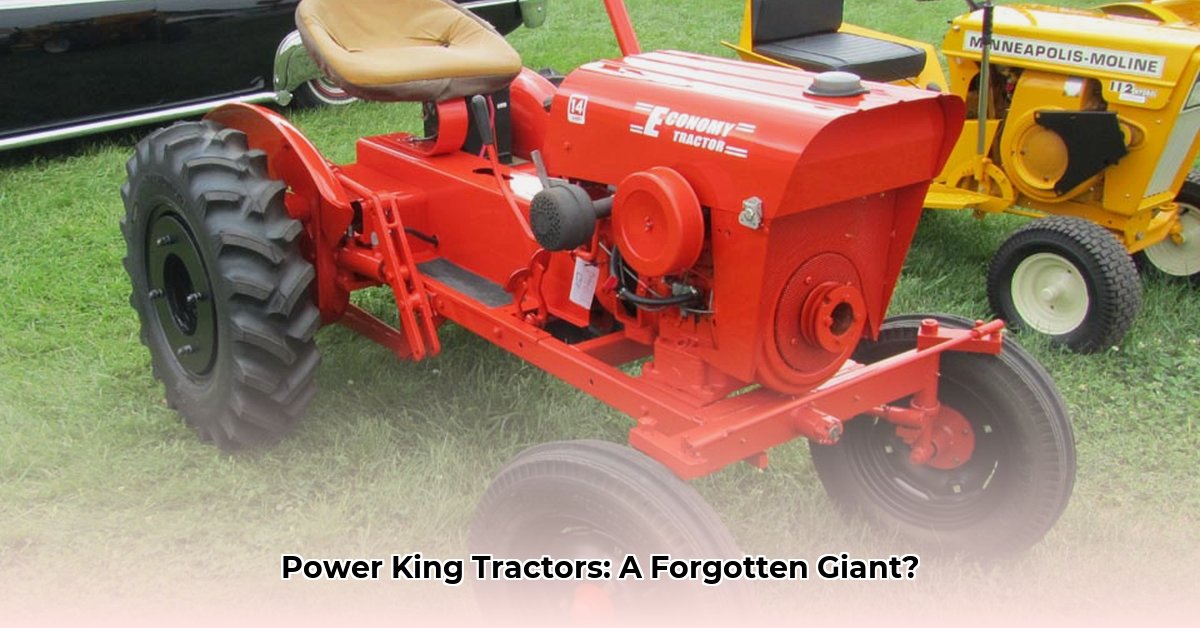
The story of the Power King tractor is more than just gears and engines; it's a microcosm of post-war American ingenuity, adaptation, and the ever-shifting landscape of consumer desires. This narrative explores its journey from humble beginnings to a recognizable brand, highlighting the clever engineering, strategic business decisions, and the evolving needs of a booming postwar economy. For more on classic tractor history, see this related site.
The Post-War Boom and the Birth of an Economy Tractor
The end of World War II ushered in an era of unprecedented growth in the United States. Suburban sprawl accelerated, creating a burgeoning demand for reliable, affordable machinery to maintain the newly burgeoning lawns and gardens. In 1946, the Engineered Products Company (EPCO) seized this opportunity, introducing its first "Economy" tractor. This wasn't a revolutionary design, but a masterclass in resourcefulness. Utilizing readily available parts—a testament to post-war ingenuity—EPCO kept costs low, making the tractor accessible to a broad market. This practical, affordable workhorse quickly became a mainstay in the lawn care world. Wasn't this shrewd business acumen a key factor in its initial success?
A Clever Approach: Adaptability and Efficiency
EPCO's early success wasn't solely about innovative technology; it was about tactical adaptability. By leveraging readily available components, the company could quickly respond to fluctuating demand and material shortages. If one part became scarce, they readily substituted it with an available alternative, demonstrating remarkable agility in a dynamic market. This flexibility allowed them to maintain production and meet consumer needs, a stark contrast to competitors who might have been hampered by supply chain issues.
From "Economy" to "Power King": More Than Just a Name Change
By 1977, the "Economy" tractor underwent a transformation, adopting the name "Power King." This wasn't merely a marketing ploy; it signified a strategic shift. Initially, the emphasis was solely on affordability. However, as the market evolved, consumers increasingly valued brand recognition and perceived quality. The name change reflected this broader trend: consumers weren't simply seeking the lowest price; they were looking for dependable, recognizable brands. This transition from a budget alternative to an established brand was a critical turning point in the company's trajectory.
Model Evolution: Reflecting Market Changes
The evolution of Power King's model naming conventions mirrors this broader market shift. Early models bore descriptive names like "14-horse Power King with 24" wheels," showcasing individual features. Later, a numerical system ("1614," "2414") was adopted, suggesting a move towards streamlined production and sophisticated marketing – a reflection of a maturing and more complex consumer market. This transition highlights the shift from bespoke production to the efficiencies of mass-manufacturing.
The Legacy of the Power King Tractor: A Historical Artifact
The Power King's legacy extends beyond its functional role. Today, restoration and maintenance present challenges for enthusiasts, primarily due to the inconsistent naming and part identification across various early models. This presents an intriguing paradox: the very inconsistencies of early production make these tractors valuable historical artifacts. They offer a unique window into post-war manufacturing techniques, resourcefulness, and consumer expectations, making them highly sought-after items. Museums and historians keenly recognize their value in illuminating this period of American industrial history. How has this scarcity of information affected the preservation efforts?
The Lasting Impact: Lessons for Today
The Power King narrative offers several key takeaways for businesses today. Their initial triumph highlights the value of nimble adaptation and efficient resource utilization. Later branding choices underscore the long-term impact of a carefully constructed brand identity. The Power King's story transcends mere tractor history; it serves as a case study in market responsiveness and brand building.
Looking Ahead: Ongoing Research and Unanswered Questions
Despite significant knowledge already gained, research into Power King's history continues. Scholars are currently investigating the influence of post-war resource scarcity on design choices and delving into EPCO’s internal dynamics. “Further research into Power King's advertising campaigns might provide valuable insights into the effectiveness of their branding strategies,” explains Dr. Amelia Hernandez, Professor of Business History at the University of California, Berkeley. This ongoing inquiry promises to further refine our understanding of this fascinating chapter in American manufacturing. What aspects of the Power King story remain to be fully explored?
Stakeholder Impact
| Stakeholder Group | Short-Term Impact | Long-Term Impact |
|---|---|---|
| Collectors/Restorers | Difficulty locating parts due to inconsistent early model naming. | Increased collaboration among collectors; development of online resources for part identification and restoration. |
| Agricultural Historians | Access to primary sources illustrating post-war manufacturing and business practices. | Enhanced understanding of the post-war economic landscape and industrial evolution in relation to agricultural machinery. |
| Museum Curators | Acquisition of significant artifacts representing a pivotal era in agricultural technology. | Curated exhibitions educating the public about the evolution of agricultural technology and its social impact. |
The Power King tractor's journey, from its economical origins to a powerful brand, provides lasting lessons about adaptation, innovation, and the vital role of brand identity in the long-term success of a product. It stands as a testament to the enduring power of American ingenuity and its reflection within the wider historical and economic context.